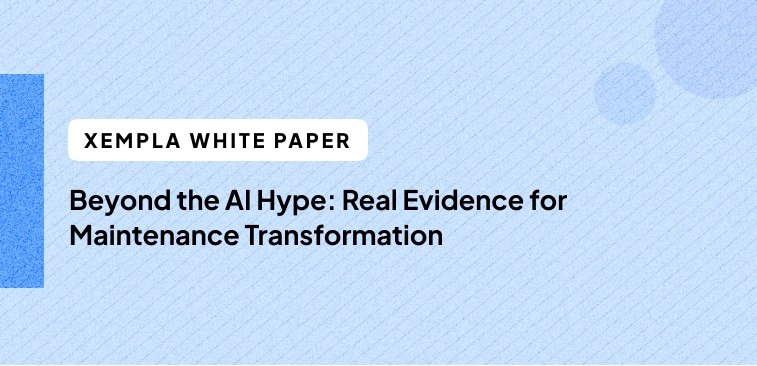
AI in maintenance has moved past the hype. This white paper presents real-world evidence showing how asset condition intelligence delivers measurable ROI — detecting hidden inefficiencies, optimizing energy use, and preventing failures that traditional methods miss. Discover how data-driven insights amplify technician expertise, expand asset visibility, and transform maintenance from reactive firefighting to predictive precision. The proof is no longer theoretical — it’s operational, financial, and happening now.
Lorem ipsum dolor sit amet, consectetur adipiscing elit, sed do eiusmod tempor incididunt ut labore et dolore magna aliqua. Ut enim ad minim veniam, quis nostrud exercitation ullamco laboris nisi ut aliquip ex ea commodo consequat. Duis aute irure dolor in reprehenderit in voluptate velit esse cillum dolore eu fugiat nulla pariatur.
Block quote
Ordered list
Unordered list
Bold text
Emphasis
Superscript
Subscript
How Asset Condition Intelligence is Delivering Measurable Results Where Traditional Approaches Fail
"AI will revolutionize maintenance" has become a familiar refrain, often met with justified skepticism from facility managers and service providers who've seen countless technologies promise transformation while delivering little more than expensive dashboards. The question isn't whether AI can theoretically improve maintenance—it's whether AI can deliver concrete, measurable value in real operational environments with real constraints and real budgets.
The evidence is emerging, and it challenges many assumptions about both AI limitations and maintenance fundamentals.
Consider this scenario: An air handling unit appears to be functioning normally. It's moving air, maintaining temperature, and hasn't triggered any alarms. Traditional maintenance protocols would classify this as a healthy asset requiring only routine service.
AI analysis tells a different story entirely.
The Hidden Reality:
The AI's Assessment: Condition Rating C1 (Deep Repair Required), Confidence: 75%
The Energy Impact: 336 kWh daily waste, equivalent to $15,000-30,000 annually per unit
This isn't theoretical—it's extracted from actual operational data where AI identified patterns invisible to conventional monitoring. The unit was "working" but failing catastrophically, hemorrhaging energy while accelerating toward complete breakdown.
The Skepticism: Maintenance involves countless variables, edge cases, and contextual nuances that AI cannot possibly understand.
The Evidence: The AHU analysis demonstrates AI's ability to synthesize multiple data streams simultaneously:
AI doesn't need to understand why these patterns indicate failure—it needs to recognize that they consistently precede failure across thousands of similar assets. The pattern recognition capability exceeds human cognitive limits for processing multiple simultaneous variables.
The Skepticism: Experienced technicians develop intuition that no algorithm can replicate.
The Counter-Perspective: AI doesn't replace intuition—it scales pattern recognition beyond human limitations. The case study shows AI identifying that "near-zero fan speed readings without pressure correlation indicate deviation from expected design behavior"—a subtle diagnostic insight that might take an experienced technician hours of investigation to uncover.
The AI's maintenance history analysis reveals another crucial insight: "Quick fixes (resetting to Auto/Hand) without addressing systemic faults" created a pattern of recurring failures. This meta-analysis of maintenance effectiveness is exactly the type of systemic thinking that AI can perform across entire portfolios simultaneously.
The Skepticism: Real energy savings are complex and context-dependent.
The Granular Analysis: The AI doesn't just report "energy waste"—it provides specific, actionable breakdowns:
This level of specificity enables precise business case development and intervention prioritization.
Most facilities achieve comprehensive condition assessment on 15-25% of their assets annually. The remaining 75-85% operate in a monitoring blind spot, degrading silently until catastrophic failure forces expensive emergency interventions.
The Mathematical Reality:
The AHU case study provides a concrete foundation for ROI calculations:
Single Asset Impact:
Portfolio Multiplication:
These are conservative estimates based on actual operational data, not projected benefits.
The case study reveals AI's ability to identify recurring issue themes that traditional approaches miss:
This systemic analysis enables a shift from treating symptoms to addressing root causes—the holy grail of maintenance optimization that has remained elusive with conventional approaches.
The AI assessment includes skills mapping for resolution:
This granular skills matching enables service organizations to deploy their most expensive resources (experienced technicians) only where truly needed, while automating the diagnostic work that traditionally consumed 40-60% of senior technician time.
Organizations implementing AI-powered condition assessment report:
Facility owners gain:
The evidence suggests that AI in maintenance is past the hype cycle and into measurable value delivery. The technology isn't replacing human expertise—it's amplifying it by handling the data processing and pattern recognition tasks that exceed human cognitive limits while freeing experts to focus on complex problem-solving.
The AHU case study demonstrates AI's ability to detect a failing asset that traditional methods would have missed until catastrophic failure, quantify the business impact with precision, and provide actionable recommendations for intervention. This isn't theoretical capability—it's operational reality.
For organizations still skeptical of AI applications, the question may no longer be whether AI can improve maintenance operations, but whether they can afford to continue operating without the comprehensive asset intelligence that AI enables.
The transformation is measurable, the ROI is demonstrable, and the competitive advantage is becoming undeniable.
The evidence speaks for itself: AI-powered maintenance is delivering results where traditional approaches reach their limits. The only question remaining is how quickly organizations will adapt to capture the value.
Lorem ipsum dolor sit amet, consectetur adipiscing elit, sed do eiusmod tempor incididunt ut labore et dolore magna aliqua. Ut enim ad minim veniam, quis nostrud exercitation ullamco laboris nisi ut aliquip ex ea commodo consequat. Duis aute irure dolor in reprehenderit in voluptate velit esse cillum dolore eu fugiat nulla pariatur.
Block quote
Ordered list
Unordered list
Bold text
Emphasis
Superscript
Subscript
© Xempla. All rights reserved.